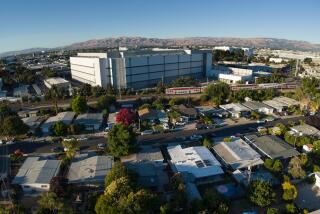‘Friendly Users’ Test New UCSD Computer
- Share via
LA JOLLA — The “friendly users” have put the new supercomputer at UC San Diego to the test and pronounced it fit for a king’s research.
The friendly users are a select group of scientists willing to run their complicated research projects on the new collection of high-speed computers here while the machines are being debugged for start-up problems. The federally funded San Diego Supercomputer Center will officially be running at capacity by mid-January, one of four centers being established nationwide to give American academicians the latest technology to stay abreast of scientific research worldwide.
“I’m impressed by the operation in San Diego,” said the first person to use the high- speed Cray computer, UC Irvine physics Prof. Herbert Hamber. “After only a few days (of test programs) earlier this month, I was able to start attacking my major research project.”
Already, Hamber said, he has accomplished a greater number of calculations in two weeks concerning his theory of how to determine the mass of elementary atomic particles than he would have obtained in two years on a slower, more common computer.
For the last week, Hamber has signed onto the supercomputer by telephone from his Irvine home. Hamber conceded a feeling of amazement at the ability to sit in his den and interact with a computer performing 100 million calculations a second.
“I’ve been running my program for two weeks and, considering the speed of the computer, you can see that my calculations have run into the billions and billions by now,” he said.
“What can I say about the machine? It’s fast,” Hamber said, adding that he has been waiting almost three years, first at Princeton University and now at UC Irvine, for the chance to test his theories fully.
Hamber and several other scientists were recruited for the debugging procedures by directors of the new center because of their familiarity with high-speed computers.
“They have to be people who have experience with these types of machines, whom we don’t have to spend time teaching, and who are willing to put up with (debugging) interruptions,” said Sidney Karin, the center’s new director. The center is a joint operation between UCSD and GA Technologies Inc. of La Jolla, a major private physics research lab for industrial uses.
Karin said many scientists are willing to “go to great lengths” to get supercomputer time and thus there was no problem in lining up Hamber and others to run programs. If major problems had developed with the new machinery and its software, the scientists would have obtained very little useful time on the computer.
However, Hamber said that, “Despite having a machine of incredible complexity--where it is not unusual for problems to persist for weeks--I was able to run test programs that gave correct results on the first day.”
Hamber said that he probably would have had to wait for months to get on the new computer had he not volunteered for the friendly users group. Already, more than 100 scientists nationwide have asked for some of the estimated 30,000 hours that will be available in 1986, Karin said. Even with the testing process continuing, 10 “friendly users” signed onto the computer Christmas Day for additional project time.
“There’s no question that we are going to have more demand than supply,” Karin said. The first priority will be given to scientists who work at one of the 18 member institutions of the supercomputer center consortium. After the center is at full speed, the computer will be able to handle several hundred persons at a time, many through telephone connections.
In addition to the debugging, Karin and his staff have been integrating the main Cray computer with several other super mini-computers as well as high speed graphics and data printers.
Because of the demands already being placed on the center, Karin hopes that plans for a second supercomputer can be implemented in 1987.






